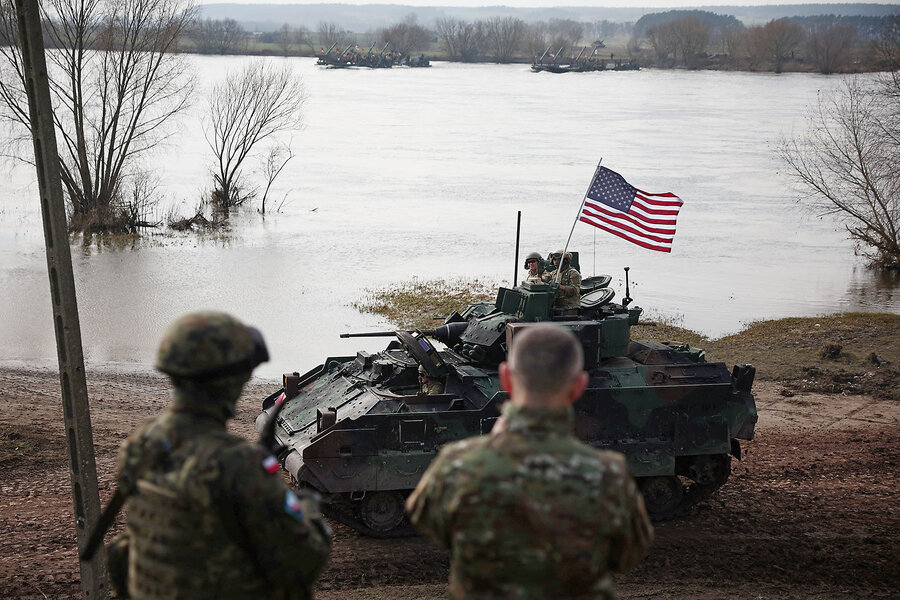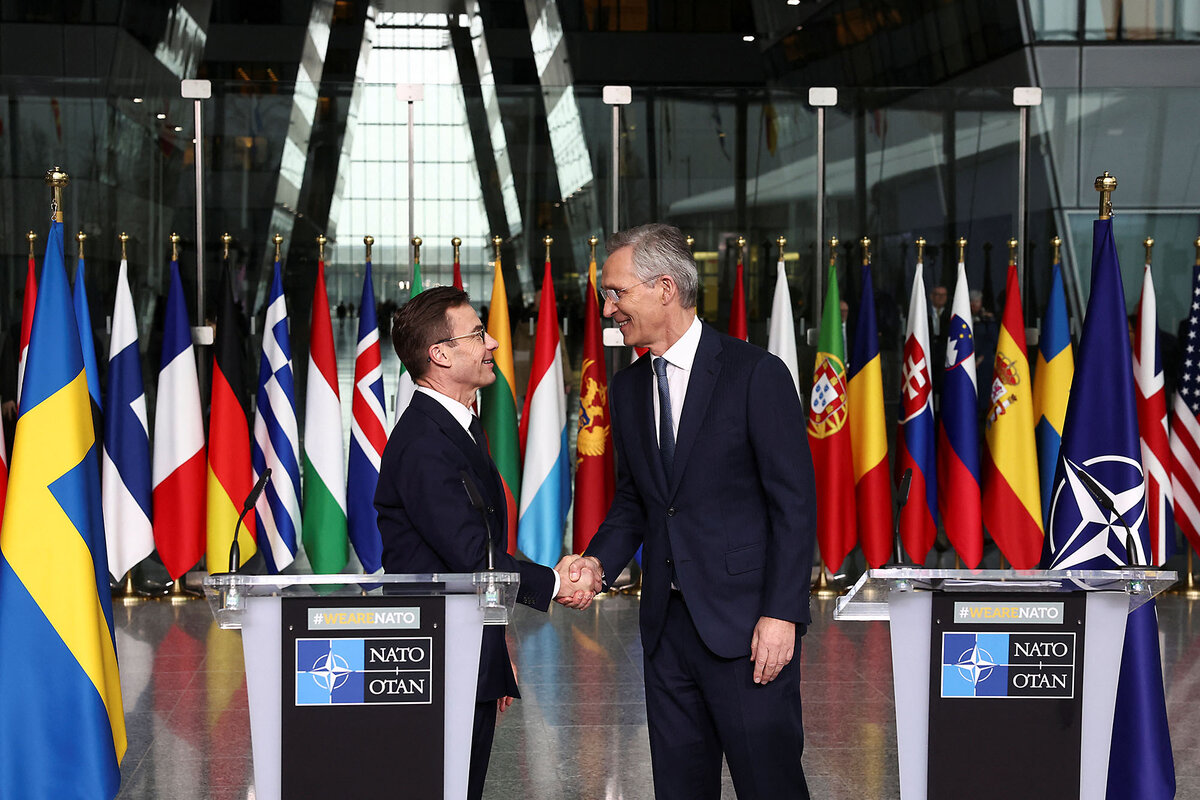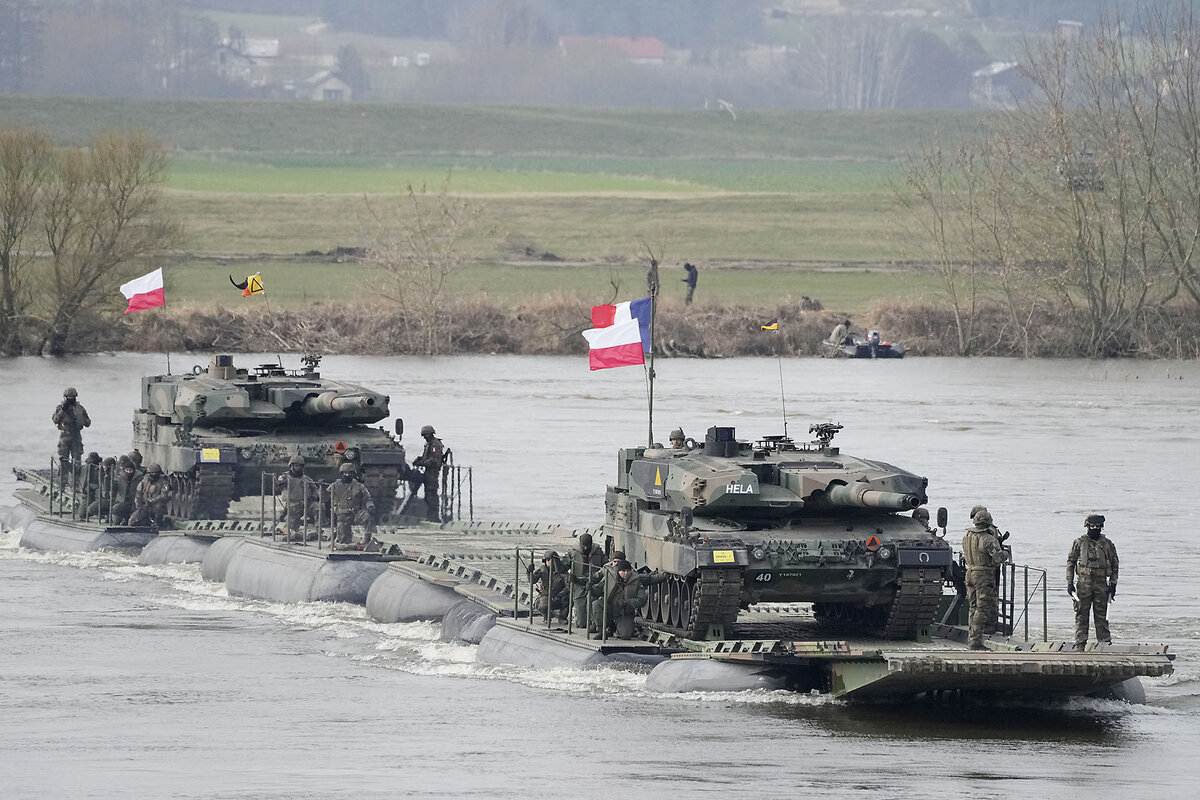With US support uncertain, Europe builds better defenses
Loading...
| KORZENIEWO, POLAND
In the run-up last month to NATO’s largest military exercises since the Cold War, a top European commander was asked what might happen if the United States quits the alliance, as Republican presidential candidate Donald Trump appears apt to do.
“I have absolutely no doubt that our biggest ally will remain committed,” insisted German Brig. Gen. Gunnar Bruegner, who leads training exercises for NATO’s Supreme Headquarters Allied Powers Europe.
Confidence in America’s military reliability remains NATO’s public default and its bedrock. But in the face of wavering Western support for Ukraine and an uncertain U.S. election, the alliance has been using these war games to suss out and strengthen its shortfalls.
Why We Wrote This
A story focused onFaced with shaky Western support for Ukraine and NATO, European leaders are taking steps to demonstrate they can defend themselves, even if less aid flows from the United States.
These are key steps, analysts say, in bolstering the credibility of an alliance that might one day have to survive without U.S. backing.
Earlier this month, in a small Polish town south of Gdansk, waves of tanks from France, Germany, Spain, and Turkey, among other member nations, crossed Poland’s longest river, the Vistula, on floating bridges designed to test how quickly the alliance can speed reinforcements to the east in the event of a Russian invasion.
“NATO’s really picked up their game to go, ‘How do we get together more? How do we take the lessons learned that we’ve been talking about and understand the challenges?’” says American Maj. Gen. Randolph Staudenraus, a NATO operations specialist, surveying the scene from the riverbank. “We want to be a better fighting force.”
European Union leaders, too, are taking steps to demonstrate, in the face of some serious doubts, that they can defend themselves without U.S. aid – if they must. The question, analysts add, is whether these steps will be enough.
Addressing funding and capability gaps
Such questions crescendoed after a South Carolina campaign rally last month, when Mr. Trump announced that he would let Russia “do whatever the hell they want” to NATO members “delinquent” in their dues. “I would not protect you,” he added.
These comments – which some European officials likened to a mafia-style shakedown – caused NATO Secretary-General Jens Stoltenberg, a stolid, Scandinavian sort, to bristle: “Any suggestion that we are not standing up for each other, that we are not going to protect each other, that does undermine the security of all of us.”
Mr. Trump’s remarks harkened back to a longstanding rub in trans-Atlantic relations: Although America and Eastern European nations have long lobbied fellow NATO allies to contribute a minimum of 2% of their gross domestic product to defense spending, by the end of 2023, only 11 of 31 members had met this goal.
Seven more countries will hit the 2% mark in 2024, NATO officials are quick to point out. They note, too, that overall European military outlays reached a record high of $295 billion last year.
At the same time, EU officials are working to strengthen the Continent’s overall military posture after the war in Ukraine exposed “significant capability gaps” within the European defense industry, including in basics like producing ammunition, notes Sophia Besch, European program fellow at the Carnegie Endowment for International Peace.
The EU acknowledged in January, for example, that it would fall nearly 50% short of the pledge it made last year to send 1 million artillery rounds to Ukraine by March – a blow to confidence in European cooperation.
The EU’s top diplomat, Josep Borrell, said the ammunition would instead be ready by year’s end. Ramping up the bloc’s defense industry, he added, is “a work in progress.”
In an effort to speed along this work, the European Commission earlier this month released its first-ever defense industrial strategy. The goal is to tap into the economic benefits that come with cooperation – to buy in bulk, buy together, and buy European – much as the EU did during the COVID-19 pandemic, Ms. Besch said in a discussion at the Brookings Institution last week.
The problem is that leaders of EU member nations are often inclined to use their defense budgets to promote protectionism and national political interests – goals that in the moment might seem more pressing than increasing the bloc’s production efficiencies.
The EU plan has also been undermined by moves like European nations including Poland – which spends upward of 3% of its GDP on defense – buying “an astonishing” $120 billion worth of weapons from American defense contractors, says Nick Witney, senior policy fellow at the European Council on Foreign Relations.
This big spending amounts in part to bilateral bids, he adds, to curry Mr. Trump’s favor in the event of a presidential election win.
The power of NATO
The U.S., for its part, has long encouraged these purchases, both to bolster the American arms industry and to reinforce European dependence on – and deference to – Washington, notes Rajan Menon, director of the grand strategy program at Defense Priorities, a think tank that advocates for more restrained U.S. foreign policy.
But the idea that rich European nations can’t ultimately come together to deter and, if necessary, to beat Russia without U.S. aid defies credulity, Dr. Menon says.
Russia has one-third of the population of the EU and ranks an unimpressive 44th on a recent list of the world’s most technologically advanced countries, he notes.
Until recently, Russia had a military force of some 800,000 regulars. In December, the Kremlin put that figure at 1.32 million. This is, perhaps not coincidentally, the rough size of America’s active duty force of 1.33 million. With the recent additions of Finland and Sweden to NATO, alliance countries, excluding the U.S., have a total of 1.53 million active duty troops.
The Russian air force has been largely absent in Ukraine, and much of Moscow’s navy is now at the bottom of the Black Sea thanks to Kyiv’s blows, Mr. Witney adds. “It’s very easy to assume that the Russians are 10 feet tall and work yourself into a panic.”
And there’s good reason to believe that Russia takes NATO very seriously, even if some U.S. politicians don’t.
“I’ve long felt that Georgia first and then Ukraine got hit in the neck precisely because they were not members of NATO – and that attacking NATO would be a wholly different enterprise for Russia to contemplate,” Mr. Witney says.
Considerable questions remain about how a nuclear deterrence umbrella would work without the U.S. But given a potential presidential victory for Mr. Trump and growing bipartisan U.S. concern about China’s martial aims, Europe would be wise to grapple with its overall defense posture while bolstering its own collective military might sooner rather than later, analysts say.
“Europe should have the means to defend itself,” Dr. Menon says, “in the event that 1-800-Uncle Sam fails to get a response.”








